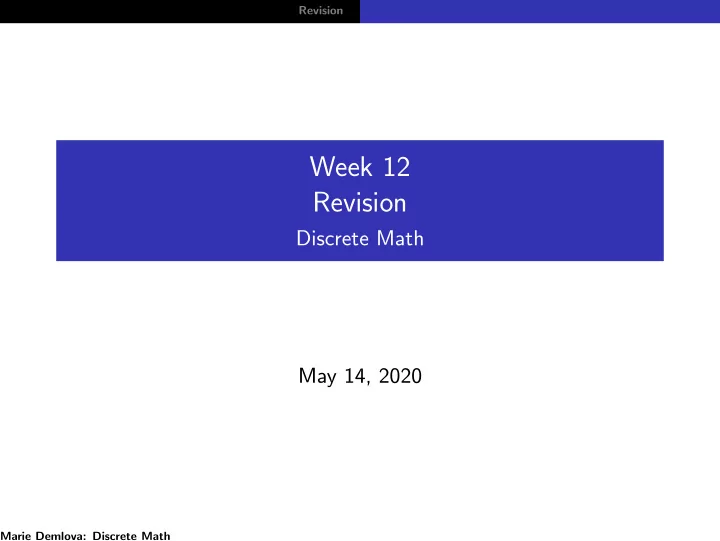

Revision Week 12 Revision Discrete Math May 14, 2020 Marie Demlova: Discrete Math
Revision Revision Example 1 Let A = { 0 , 1 , 2 , 3 , 4 , 5 } . Define a mapping f : A → A is defined by f ( x ) = k , where k ≡ 4 x ( mod 6 ) . Decide whether f is one-to-one (injective), and whether f is onto (surjective). Example 2 Let f : X → Y and g : Y → Z be two mappings Decide whether the following statement is true or false: If f and g are one-to-one then so is g ◦ f . Marie Demlova: Discrete Math
Revision Revision Example 3 Give examples of sets A and B such that they are infinite sets with the same cardinality. Example 4 Let A = { ( p , q ) | p is an even integer, and q is an odd integer } . Decide whether A is a countable set. If yes, give the reasons. Marie Demlova: Discrete Math
Revision Revision Example 5 Given a relation R on the set of all natural numbers N by m R n iff m − n is divisible by 3 and by 5 . 1. Decide whether R is reflexive (define a reflexive relation ). 2. Decide whether R is symmetric (define a symmetric relation ). 3. Decide whether R is antisymmetric (define an antisymmetric relation ). 4. Decide whether R is transitive (define a transitive relation ). Marie Demlova: Discrete Math
Revision Revision Example 6 By mathematical induction prove that for every natural number n ≥ 1 it holds that 6 · 7 n + 2 · 3 n is divisible by 4. Example 7 By mathematical induction prove that for every natural number n ≥ 1 it holds that 2 n + 1 < 1 + ( n + 1 ) 2 n . Marie Demlova: Discrete Math
Revision Revision Example 8 Find all pairs of integers x and y for which 319 x + 473 y = 0 . Example 9 Find all the pairs of integers x and y for which 10 x − 15 y = 131 . Marie Demlova: Discrete Math
Revision Revision Example 10 Find the remainder when you divide 4 254 + 2 · 17 123 − 3 · 13 102 . by 15. Example 11 In ( Z 153 , + , · ) an equation is given 14 580 ( x + 1 ) = 22 − 8 x . Find all its solutions. Marie Demlova: Discrete Math
Revision Revision Example 12 An operation ∗ is defined on the set Z × Z , i.e. the set containing all pairs of integers by: ( u , v ) ∗ ( x , y ) = ( u + x , v · y ) . 1. Show that the pair ( Z × Z , ∗ ) forms a semigroup. Write down what is a semigroup . 2. Find a neutral element of the semigroup ( Z × Z , ∗ ) . Write down what is a neutral element . 3. Find all invertible elements of the monoid ( Z × Z , ∗ ) . Write down what is an invertible element . 4. If ( Z × Z , ∗ ) is not a group find an equation that does not have a solution. Is there an equation that has more than one solution? Justify your answers. Marie Demlova: Discrete Math
Revision Revision Example 13 Given the group of invertible elements of ( Z 22 , · ) . Decide whether it is a cyclic group. Yes or no does not suffice, you have to justify your answer. Example 14 Given the group of invertible elements ( Z ⋆ 22 , · ) . How many 22 , · ) can have? For each such number elements a subgroup of ( Z ⋆ find a subgroup with this number of elements. Marie Demlova: Discrete Math
Revision Revision Example 15 The characteristic equation of a homogeneous linear difference equation of order 3 has roots λ 1 = 1, and λ 2 , 3 = − 2 (i.e. the root λ = − 2 has multiplicity 2). What is the general solution of this homogeneous linear difference equation? Example 16 Solve the following difference equation a n + 2 − 3 a n + 1 + 2 a n = 6 · 2 n , a 0 = 2 , a 1 = 6 . Marie Demlova: Discrete Math
Revision Revision Example 16 Given functions 4 n , e n , ln( n !) , ln ln n , n lg n , ln( n ln n ) , n , √ n , 1 n . Sort these functions in f 1 , f 2 , . . . , such that f i ∈ O ( f i + 1 ) where i = 1 , 2 , . . . State all the pair of functions f , g for which f ∈ Θ( g ) . Example 17 Prove the following assertion: Given three non negative functions f ( n ) , g ( n ) , and h ( n ) for which there exists n 0 ∈ N such that for every n ≥ n 0 g ( n ) ≤ f ( n ) ≤ h ( n ) . Assume that g ( n ) ∈ Ω( k ( n )) and h ( n ) ∈ O ( k ( n )) . Then f ( n ) ∈ Θ( k ( n )) . Marie Demlova: Discrete Math
Recommend
More recommend